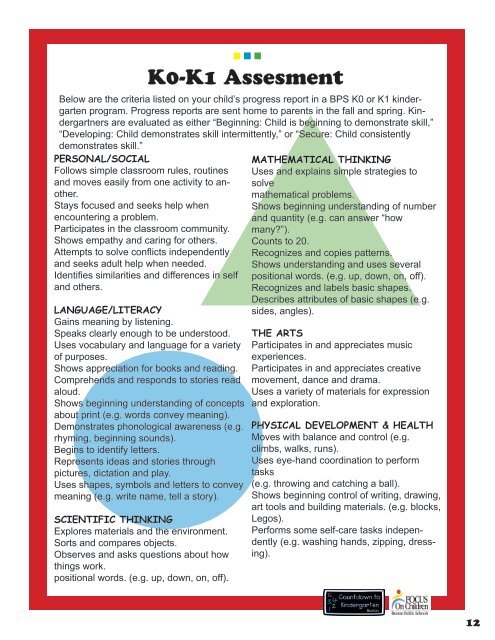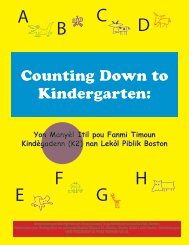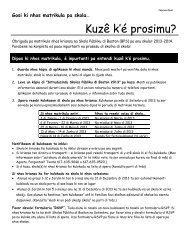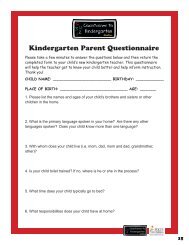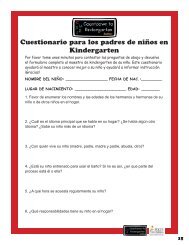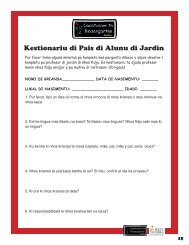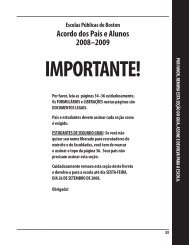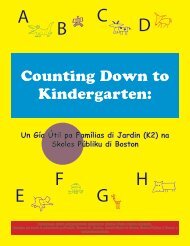Kindergarten Handbook - Countdown to Kindergarten
Kindergarten Handbook - Countdown to Kindergarten
Kindergarten Handbook - Countdown to Kindergarten
Create successful ePaper yourself
Turn your PDF publications into a flip-book with our unique Google optimized e-Paper software.
demonstrates skill.”<br />
PERSONAL/SOCIAL<br />
Follows simple classroom rules, routines<br />
and moves easily from one activity <strong>to</strong> another.<br />
Stays focused and seeks help when<br />
encountering a problem.<br />
Participates in the classroom community.<br />
Shows empathy and caring for others.<br />
Attempts <strong>to</strong> solve conflicts independently<br />
and seeks adult help when needed.<br />
Identifies similarities and differences in self<br />
and others.<br />
K0-K1 Assesment<br />
Below are the criteria listed on your child’s progress report in a BPS K0 or K1 kindergarten<br />
program. Progress reports are sent home <strong>to</strong> parents in the fall and spring. Kindergartners<br />
are evaluated as either “Beginning: Child is beginning <strong>to</strong> demonstrate skill,”<br />
“Developing: Child demonstrates skill intermittently,” or “Secure: Child consistently<br />
LANGUAGE/LITERACY<br />
Gains meaning by listening.<br />
Speaks clearly enough <strong>to</strong> be unders<strong>to</strong>od.<br />
Uses vocabulary and language for a variety<br />
of purposes.<br />
Shows appreciation for books and reading.<br />
Comprehends and responds <strong>to</strong> s<strong>to</strong>ries read<br />
aloud.<br />
Shows beginning understanding of concepts<br />
about print (e.g. words convey meaning).<br />
Demonstrates phonological awareness (e.g.<br />
rhyming, beginning sounds).<br />
Begins <strong>to</strong> identify letters.<br />
Represents ideas and s<strong>to</strong>ries through<br />
pictures, dictation and play.<br />
Uses shapes, symbols and letters <strong>to</strong> convey<br />
meaning (e.g. write name, tell a s<strong>to</strong>ry).<br />
SCIENTIFIC THINKING<br />
Explores materials and the environment.<br />
Sorts and compares objects.<br />
Observes and asks questions about how<br />
things work.<br />
positional words. (e.g. up, down, on, off).<br />
MATHEMATICAL THINKING<br />
Uses and explains simple strategies <strong>to</strong><br />
solve<br />
mathematical problems.<br />
Shows beginning understanding of number<br />
and quantity (e.g. can answer “how<br />
many?”).<br />
Counts <strong>to</strong> 20.<br />
Recognizes and copies patterns.<br />
Shows understanding and uses several<br />
positional words. (e.g. up, down, on, off).<br />
Recognizes and labels basic shapes.<br />
Describes attributes of basic shapes (e.g.<br />
sides, angles).<br />
THE ARTS<br />
Participates in and appreciates music<br />
experiences.<br />
Participates in and appreciates creative<br />
movement, dance and drama.<br />
Uses a variety of materials for expression<br />
and exploration.<br />
PHYSICAL DEVELOPMENT & HEALTH<br />
Moves with balance and control (e.g.<br />
climbs, walks, runs).<br />
Uses eye-hand coordination <strong>to</strong> perform<br />
tasks<br />
(e.g. throwing and catching a ball).<br />
Shows beginning control of writing, drawing,<br />
art <strong>to</strong>ols and building materials. (e.g. blocks,<br />
Legos).<br />
Performs some self-care tasks independently<br />
(e.g. washing hands, zipping, dressing).<br />
12


